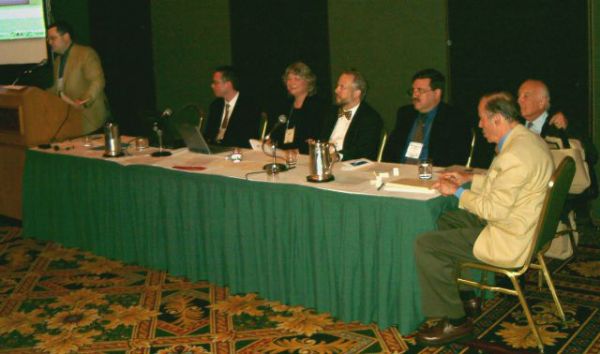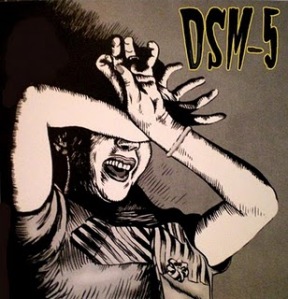Kelley Winters, Ph.D.
GID Reform Advocates
http://www.gidreform.org
On the April 18th broadcast of The Rachel Maddow Show, Dr. Maddow reported an “explosive revelation” that Psychiatrist Robert Spitzer had rescinded his controversial 2001 claim that sexual conversion, or sexual reparative, psychotherapies can change sexual orientation in gay and lesbian people. Quoting an interview of Dr. Spitzer in The American Prospect, Maddow celebrated the historical significance of Spitzer’s reversal for the gay rights movement, calling it,
step one in what we’re now going to see as a real change, a real reckoning, in antigay politics.
Sadly, Dr. Maddow only told half of the story. For four decades, Robert Spitzer has played pivotal roles in mental health policies, not only on sexual orientation, but on gender diversity as well. This week, Rachel Maddow and other journalists turned a blind eye to Dr. Spitzer’s failure to retract a lifetime of trans psychopathologization, stereotyping gender identities and expression that differ from assigned birth roles as mental disease. This omission speaks to the marginal status of trans people within the GLbt rights movement and progressive media, as much as Spitzer’s omission speaks to trans marginalization by mental health policymakers. Shifting stigma from one oppressed class to a more oppressed class is not real change.
At the 1973 annual meeting of the American Psychiatric Association, Robert Spitzer played a central role in arguing for declassification of same-sex orientation as mental illness:
In the past, homosexuals have been denied civil rights in many areas of life on the ground that because they suffer from a ‘mental illness’ the burden of proof is on them to demonstrate their competence, reliability, or mental stability.
This led to the gradual deletion of sexual orientation categories from the Diagnostic and Statistical Manual of Mental Disorders (DSM) between 1973 and 1987. The DSM is published by the American Psychiatric Association and remains the medical and cultural definition of mental disorder in North America. As Chairman of the DSM-III and DSM-III-R Task Forces and chief editor of the diagnostic manual, Spitzer oversaw removal of the last major vestige of gay diagnosis, “Ego-dystonic Homosexuality,” from version III-R.
However, while depathologizing same-sex orientation, Dr. Spitzer simultaneously directed a massive expansion of trans-pathology diagnoses in the DSM. In 1980, a new category of Gender Identity Disorders (GID), including a Transsexualism (TS) diagnosis, was added to the class of Psychosexual Disorders in the DSM-III. The TS coding was paradoxical and controversial for many trans people. Many community advocates and medical providers agreed (and do today) that some kind of diagnostic coding was necessary to facilitate access to medical and/or surgical transition care for those trans and transsexual people who needed it. On the other hand, defining a medical transition coding as a mental illness, rather than a treatable medical condition, contradicted access to hormonal and/or surgical transition care and encouraged gender conversion, or gender-reparative, psychotherapies— unsubstantiated treatments attempting to change gender identity and shame trans and TS people into the closets of their assigned birth roles. Vulnerable trans and gender nonconforming youth were targeted and institutionalized as a consequence of diagnostic criteria based on nonconformity to birth-assigned stereotypes.
In the DSM III-R, Dr. Spitzer’s Task Force expanded the diagnostic criteria for children to emphasize gender role nonconformity for birth-assigned girls, including “persistent marked aversion to normative feminine clothing” (whatever that means). Even more damaging, a new category was added, Gender Identity Disorder of Adolescence or Adulthood, Nontranssexual Type (GIDAANT), to psychopathologize for the first time the gender identities of trans people who did not need access to medical transition care.
The disorder of Transvestism in the DSM-III was renamed “Transvestic Fetishism” in the DSM-III-R, to further stigmatize crossdressing or gender nonconformity by birth-assigned males as sexual obsession. This change served to sexualize a diagnosis that did not clearly require a sexual context in its diagnostic criteria. The DSM-IV Casebook, edited by Dr. Spitzer in 1994, went even further in pathologizing gender nonconformity, recommending a Transvestic Fetishism diagnosis for a self-accepting bigender male, whose crossdressing was not necessarily erotically motivated and whose primary distress was his spouse’s intolerance.
In 2001, Robert Spitzer tacked to the political right on sexual orientation, presenting a paper entitled,”Can Some Gay Men and Lesbians Change Their Sexual Orientation? 200 Participants Reporting a Change from Homosexual to Heterosexual Orientation,” to the Annual Meeting of the American Psychiatric Association. It was published in the Archives of Sexual Behavior two years later. Spitzer promoted sexual conversion, or sexual-reparative, psychotherapies as “a rational choice” and affirmed their efficacy, stating,
there is evidence that change in sexual orientation following some form of reparative therapy does occur in some gay men and lesbians.
Moreover, Spitzer denied mounting evidence that sexual-reparative psychotherapies cause harm and even criticized the American Psychiatric Association for denouncing the practice as unethical. At the same time, he revealed his bias on gender diversity and gender conversion therapies, describing “a greater sense of masculinity in males, and femininity in females,” as a therapeutic “benefit.”
By 2003, Dr. Spitzer’s statements had drawn a firestorm of dissent from GLB communities and supportive mental health professionals. Wayne Besen, founder of Truth Wins Out, characterized Spitzer’s study as,
just the latest attempt by the political religious right to gain legitimacy for their arguments by teaming up with a supposedly unbiased scientist.
Indeed, antigay extremists, including the National Association for Research & Therapy of Homosexuality (NARTH), embraced the Spitzer paper as mainstream endorsement of their sexual-reparative psychotherapies:
These results would seem to contradict the position statements of the major mental health organizations in the United States, which claim there is no scientific basis for believing psychotherapy effective in addressing same-sex attraction. Yet Spitzer reports evidence of change in both sexes…
Spitzer’s response to mounting criticism of his scientific rigor was to backpedal from his “rational choice” position, clarifying, “Of course no one chooses to be homosexual and no one chooses to be heterosexual.” At the very same time, however, he doubled down on his characterization of trans people as mentally defective.

Sexual and Gender Identity Disorders symposium from the 2003 APA Annual Meeting. From the left, Drs. Karasic (speaking), Hill, Winters, Moser, Drescher, Spitzer (front), and Fink.
In May, 2003, Dr. Spitzer and I presented papers to a symposium entitled, “Sexual and Gender Identity Disorders: Questions for the DSM-V” at the Annual Meeting of the American Psychiatric Association. The only trans person and non-clinical scholar in the session, I sat on the left side of the stage table with presenters advocating reform of the Gender Identity Disorder (GID) and paraphilia diagnoses in the DSM-5. At the far right end of the table, Spitzer joined former APA President Dr. Paul Fink in defending the status quo. Spitzer wasted no time in invoking the worn stereotype of disordered gender identity:
Children normally develop a sense of gender identity. It is not taught—it just happens. I would argue that by itself, the failure to develop a gender identity that is congruent with biological gender is a dysfunction.
He continued, plodding down a path of cave-man essentialism:
In all cultures, young boys want to play with boys, Young girls want to play with girls… If you are interested in evolutionary psychology, you ask yourself could that have some survival value? The answer is yes. Thousands of years ago when men were more likely to be in hunting and women were more likely to be in the nurturing role, if you were a young boy you would do better if you spent your time with other boys with whom, when you were older, you would go to the hunt.
And Spitzer didn’t stop there, adding, “…in all cultures, gender is recognized as a dichotomy.”
This could not be further from the truth. Global human history holds a great many indigenous cultures with more than two recognized sex and gender roles. These include Tahitian and Hawaiian Mahu, Madagascar Sekrata, Hindu Tantric and Hijra Sects, Islamic Xanith, Khawal, and Sufi traditions and numerous Native American, or First Nation, Two Spirit traditions, and many others.
At the 2003 APA Meeting, Dr. Spitzer disparaged gender variant identities and expressions as pathological if they did not serve functions that he termed, “expected.” In my 2008 book, Gender Madness in American Psychiatry: Essays from the Struggle for Dignity, I questioned his evolutionary speculations,
who gets to decide what is ‘expected’? From whose perch of social privilege is American psychiatry to pass judgment upon the evolutionary worthiness of a class of people who have survived since human antiquity?
In the May, 2006, issue of Congressional Quarterly Researcher, Robert Spitzer debated UC San Francisco psychiatrist Dan Karasic on the question of GID as a mental illness. Spitzer used his most defamatory language to date to argue that well adjusted post-transition adults should continue to be regarded as mentally ill, so long as they deviate from their birth-assigned sex roles:
Granted that hormone therapy or surgery may now be the only treatment that we can now offer the adult with GID… But surely something remains profoundly wrong psychologically with individuals who are uncomfortable with their biological sex and insist that their biological sex is of the opposite sex. The only diagnosis that is appropriate for such cases is GID.
In issues of social discrimination, historic context matters. Cisgender GLB people had every right to their outrage at Spitzer’s 2001 attack on their dignity. This week, they had cause to celebrate his retraction. Wayne Besen noted that,
Spitzer just kicked out the final leg from the stool on which the proponents of ‘ex-gay’ therapy based their already shaky claims of success.
Perhaps, but trans and especially transsexual people are not celebrating. Dr. Spitzer and like-minded policymakers in American Psychiatry have long kicked the the legs from under our human legitimacy, and the rush to his redemption in progressive media has cast our issues aside once again.
We too have been injured by Robert Spitzer’s role in perpetuating defamatory stereotypes of mental “dysfunction” and deviance. Trans people continue to lose our jobs, homes, children, families, dignity and civil justice because of these stereotypes and continue to face predatory gender conversion psychotherapies. These stereotypes lie behind every extremist political campaign that demeans our most basic civil rights as “bathroom bills.” These stereotypes lie behind military discrimination and government policies that still malign us as “mentally unfit.” These stereotypes convince parents and school officials to dismiss trans youth as “confused” or going through “a phase.” Trans communities have waited more than two decades for a retraction or an apology from Dr. Spitzer. and we are still waiting.
Copyright © 2012 Kelley Winters, GID Reform Advocates




